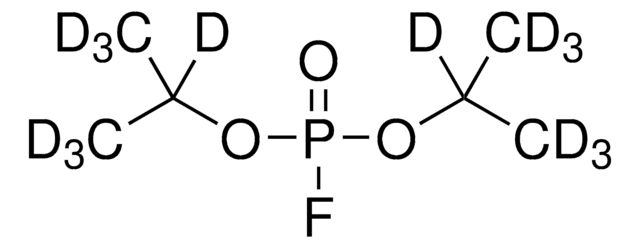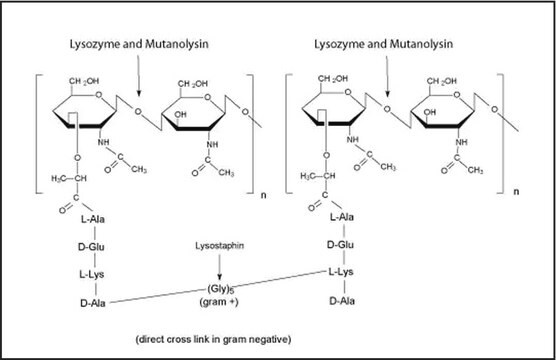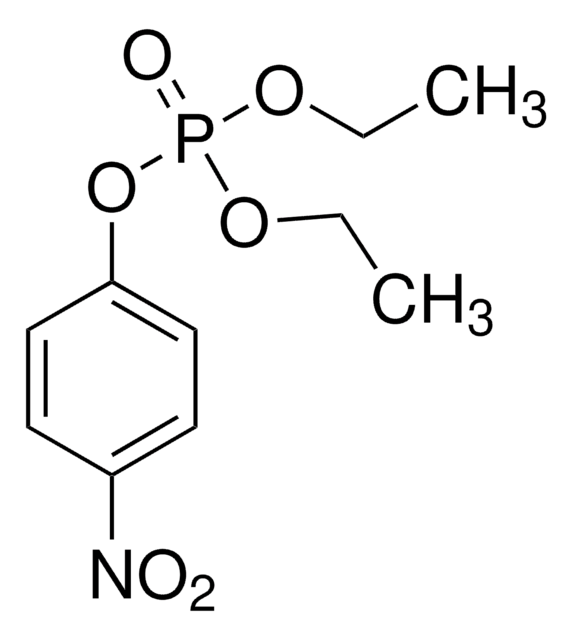14202
Diisopropyl-fluorophosphatase
≥30 U/mg
Se connecterpour consulter vos tarifs contractuels et ceux de votre entreprise/organisme
About This Item
Produits recommandés
Source biologique
fermentation/recombinant
Niveau de qualité
Forme
lyophilized solid
Activité spécifique
≥30 U/mg
Température de stockage
−20°C
Conditionnement
Bottomless glass bottle. Contents are inside inserted fused cone.
Définition de l'unité
One unit corresponds to the amount of enzyme which hydrolyzes 1 μmol diisopropyl fluorophosphate per minute at pH 8.1 and 22 °C
Mention d'avertissement
Danger
Mentions de danger
Conseils de prudence
Classification des risques
Resp. Sens. 1
Code de la classe de stockage
11 - Combustible Solids
Classe de danger pour l'eau (WGK)
WGK 1
Point d'éclair (°F)
Not applicable
Point d'éclair (°C)
Not applicable
Équipement de protection individuelle
Eyeshields, Gloves, type N95 (US)
Faites votre choix parmi les versions les plus récentes :
Certificats d'analyse (COA)
Lot/Batch Number
Vous ne trouvez pas la bonne version ?
Si vous avez besoin d'une version particulière, vous pouvez rechercher un certificat spécifique par le numéro de lot.
Déjà en possession de ce produit ?
Retrouvez la documentation relative aux produits que vous avez récemment achetés dans la Bibliothèque de documents.
Marc-Michael Blum et al.
Chemico-biological interactions, 187(1-3), 373-379 (2010-03-09)
The calcium-dependent phosphotriesterase diisopropyl fluorophosphatase (DFPase) from the squid Loligo vulgaris efficiently hydrolyzes a wide range of organophosphorus nerve agents. The two calcium ions within DFPase play essential roles for its function. The lower affinity calcium ion located at the
Gabriel Amitai et al.
The FEBS journal, 273(9), 1906-1919 (2006-04-28)
We addressed the ability of various organophosphorus (OP) hydrolases to catalytically scavenge toxic OP nerve agents. Mammalian paraoxonase (PON1) was found to be more active than Pseudomonas diminuta OP hydrolase (OPH) and squid O,O-di-isopropyl fluorophosphatase (DFPase) in detoxifying cyclosarin (O-cyclohexyl
Andreas R Günthert et al.
American journal of obstetrics and gynecology, 191(4), 1164-1172 (2004-10-28)
Eighty percent of human ovarian and endometrial cancers express receptors for luteinizing hormone-releasing hormone (LHRH-R). These receptors can be used for targeted chemotherapy with agents such as AN-152, in which doxorubicin is linked to analog [D-Lys(6)]-LHRH. Direct receptor-mediated antiproliferative effects
Jürgen Gäb et al.
Analytical biochemistry, 385(2), 187-193 (2008-12-17)
The enzyme diisopropyl fluorophosphatase (DFPase) from the squid Loligo vulgaris effectively catalyzes the hydrolysis of diisopropyl fluorophosphate (DFP) and a number of organophosphorus nerve agents, including sarin, soman, cyclosarin, and tabun. Up to now, the determination of kinetic data has
Robert C diTargiani et al.
Chemico-biological interactions, 187(1-3), 349-354 (2010-02-24)
A novel approach for treating organophosphorus (OP) poisoning is the use of enzymes, both stoichiometric and catalytic, as bioscavengers to sequester these compounds in circulation before they reach their physiological targets. Human serum butyrylcholinesterase and a recombinant form of this
Notre équipe de scientifiques dispose d'une expérience dans tous les secteurs de la recherche, notamment en sciences de la vie, science des matériaux, synthèse chimique, chromatographie, analyse et dans de nombreux autres domaines..
Contacter notre Service technique







